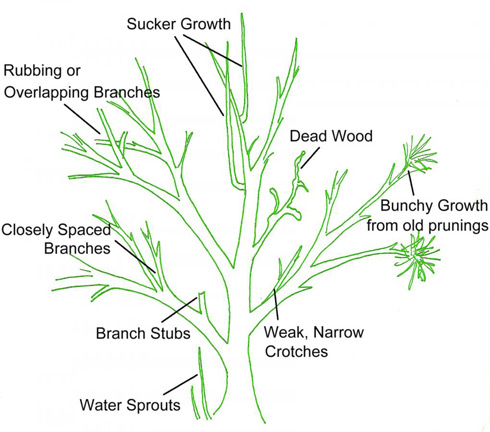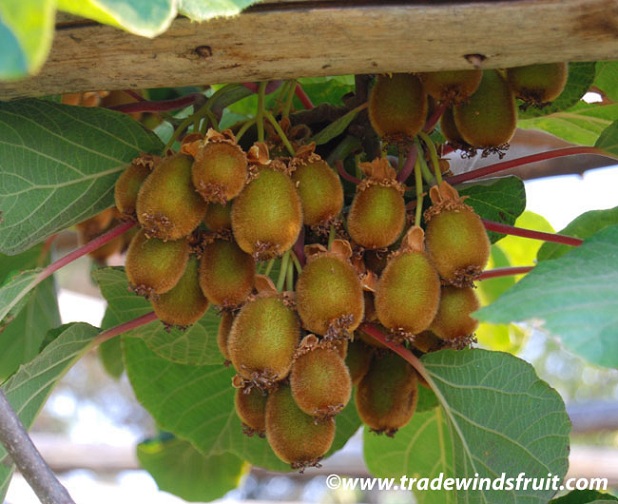|
Edible Fruits of Shrubs and Vines
By:
Powell Gammill
Last month I discussed fruit and nut trees. This month I would like to briefly expand to two other categories of fruit producers: shrubs and vines.
Interestingly, citrus trees were evolved by man from shrubs. This is why they behave differently from deciduous fruit trees. Like trees, shrubs and many vines are woody plants. Some can grow quite tall. But generally they are respectively thought of as bushy, or long and spindly. Yet this is somewhat dependent upon pruning. Some shrubs or vines can exist in either form depending upon the environment in which it is growing. A lot of berries are born on what we consider to be shrubs for example, blueberries, blackberries and cranberries. But sometimes a vine looks more like a shrub, for example an older grape vine in a vineyard...in fact if allowed a grape vine can get big enough to look like a tree. And besides grapes, vines can also bear other lovely fruit such as kiwis and passion fruit.
Shrubs and vines are generally perennial or biennials (two year life cycle). Often not immediately thought of when discussing vines: melons, pumpkins and tomatoes, for example, are annuals and will be discussed more in annual gardens in a future article.
Vines can climb (vertical) or trail (horizontal). Various mechanisms are used by vines in climbing and attaching to support such as an adjacent tree or man-made trellis, fence or netting.
Some vines and shrubs can be highly invasive depending upon their environment. You should check the species against reports in your state or you and your neighbors may end up battling what you plant for real estate.

Shrubs and vines have multiple uses. In this case, food is the primary one. But for example, they can provide shade overhead in the case of trellised vines, privacy in the case of a wall (hedge) made of shrubs, defining a pathway, crime control when placed in front of windows or along fences and bearing thorns, animal control, animal shelter and food, wind control and to hide unsightly objects or fencing.
Unlike trees, most shrubs and vines are producing food in their second year...some in their first. They will usually grow very fast. They are often easy to propagate by cloning.
Planting
General rule: Half of what a tree gets: A 2 x 2 foot hole. Dig a shallow trench (swale) around the crown ("tree-line") for watering. Climbing vines will need a suitable support for them to climb. Don't dismiss using a tree to get a two for one food production though a tree may shade out the vine lowering its food production. Trailing vines will either run along the ground or be tied to a support as they extend their growth off the ground.
Shade
Some exhibit partial shade (4 - 6 hours of direct sunlight a day) tolerance: Elderberry, Evergreen and Red Huckleberry, and Gooseberry. Evergreen huckleberry and currants can do well in complete shade but fruit production may be reduced. But this allows cultivation in northern sides of property and other areas completely shaded.
Wind
Shrubs are generally very wind resistant and can be helped in this respect by keeping the center pruned out and open. Additionally they can act as wind barriers protecting other more sensitive plants from prevailing winds.
Water
Water to two feet deep. Re-water when water level has shrunk to six inches. Usually water twice as often as trees.
Mulch as per trees.
Pruning
Remember why we prune? Consider the fruiting style of the shrub or vine. Some of these plants fruit on last year's growth, others on new growth. This will dictate what should and should not be pruned. It is possible to greatly harm a fruit bearing shrub by cutting with hedge trimmers for shape as this produces a packed dead interior over time. Also fruiting shrubs often fruit at their ends. Shrubs that bloom early in the growing season on last year’s growth should be pruned immediately after they finish blooming.
These are general rules, and pruning involves helping create new foliage for fruit to appear upon and removing foliage that fruit will no longer be borne upon. I am afraid each species and frequently different varieties within a species are pruned differently. You will have to look up and keep in mind which technique to apply for each plant.
Shrubs can be trimmed and formed into any desired shape. For example, shapes can be made for artistic reasons, barrier reasons, to promote fruit protection from sun or wind, to promote air flow to prevent a damp disease forming in the interior environment or usually to encourage more photosynthesis to boost fruit and sugar yields. Some can be encouraged to form a tree like shape. This is especially true with perennial shrubs or vines like grapes.
Remove suckers, broken or diseased branches. Remove excess young growth or too numerous or close together fruit. But for many established shrubs pruning is only done for dead growth removal. Size is restricted by limiting water and fertilizer which stresses the plant and can produce more fruit.

In cane training (spur pruning) that year's spurs are trimmed -- while dormant -- almost completely off leaving only the bud for next year's growth.
In spur training (cane pruning) a few canes are left alone except for some minor excess bud pruning at the ends of each cane--also while dormant. The rest are removed.
Each variety of grape is either spur or cane pruned.
Pruning often depends upon if a vine is an upright vine or a hanging (trailing) vine.
Support is usually a trellis, netting, a tree or a pole. Some vines have the ability to adhere on their own while others need help and need to be tied with non-damaging straps to support structures---frequently a wire running horizontal to the ground can be used as a guide, especially for cordons (the branching arms of the plant).
 (source:) (source:)
Fall bearing (ever-bearing) raspberries: Prune all canes to ground level. Canes that produced fruit last season will not produce again this coming season. The canes that grow this spring will bear fruit in the late summer and fall. It is possible to have a summer and fall crop with the ever-bearers. However, the summer crop will be small and this will impact the fall crop.
Summer bearing blackberries, raspberries and their hybrids: Remove all canes that produced fruit last season (the florocanes). These will not produce a crop the next year. You will then be left with the canes that were vegetative last summer (the primocanes). The primocanes will be florocanes this summer and produce a crop. Many varieties produce more canes than are needed, some strong and others weak. Remove all weak canes and then thin out the remaining canes to allow for light penetration. This will have a two-fold affect �" it will allow the remaining canes to grow strong and healthy, and it will reduce disease incidence because the foliage and canes will be able to dry faster than crowded canes. Leave four to six canes per running foot of row.
Blueberries: Blueberry bushes should have two to three canes for each year of growth up to six years of age. So that would be two to three of the strongest canes that are new from last year �" remove the rest of the new canes; two to three of the strongest canes that were new the prior year �" remove the rest of the canes that developed that year, and so on, with no canes older than six years. The reason is that the amount fruit and the berry size drops on older wood. Once your bush is older than six years, pruning would consist of removing the oldest canes, and selecting the two to three strongest new canes to keep. Blueberries bear fruit on last season’s growth, so do not prune off the tips.
Males
Kiwis have separate male and female plants where one male can federalize up to eight females. A male MUST be present for the females to set fruit. Other shrubs and vines may have a male form that will increase the yield of fruit but otherwise they are self fertile or cross pollinating (meaning having more than one variety often increases fruit production for all of the same species.

Container plants
Shrubs make good container plants. In fact, you can keep those plants that spread via sending out runners (for example blackberries) by elevating the container slightly off of the ground---roots won't grow in dry air. Good container plants are blackberries, blueberries, cranberries, currants, gooseberries, huckleberries, passionflower and raspberries.
|


